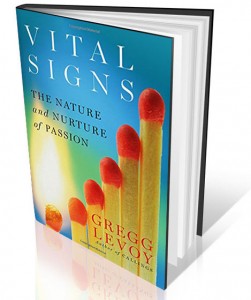The Higher Math of Being Passionate
 Here are 8 bits of wisdom on the intersection of sex and spirituality that I drew from Asheville writer Gregg Levoy’s new book, Vital Signs: The Nature and Nurture of Passion.
Here are 8 bits of wisdom on the intersection of sex and spirituality that I drew from Asheville writer Gregg Levoy’s new book, Vital Signs: The Nature and Nurture of Passion.
Though I never thought I’d have any use for algebra or the classical logic course I took (to dodge the college math requirement), somehow these thoughts sorted themselves as I read into arguments and equations. Here’s the list of eight, with quotes from the book’s chapter on being passionate as a couple. You may wish to argue with his thoughts or mine.
1. Passion = desire for union, not just for one person but for life itself
Passionate living = turn-on
Turned-on life = transcendence (of the dispirited and mundane)
Here’s the more lyrical original:
Passion is above all the hunger to connect, the desire for union, the capacity for relatedness. It’s your deep affinity for and abiding interest in not only a special someone, but in life itself. And with the whole world as the apple of your eye, all of life becomes an aphrodisiac, all desire becomes tantric, a vehicle for transcendence, and the archetype of the lover— the part of you that presides over passion, feeling, sensuality, and responsiveness— can spread into every usable niche. “The problem is not desire,” the Indian spiritual teacher Sri Nisargadatta once said. “It’s that your desires are too small.”
2. Romantic love = being passionate in a spiritual quest for the ideal
And if romantic love seems a lot like spiritual yearning in its goal of ecstasy and transcendence, ultimate meaning, a sense of unity and completion, it’s because the Western notion of romantic love was invented as a spiritual path. It began as “courtly love” among the nobility in the Middle Ages, … It was an idealized relationship in that it didn’t typically exist in the “real life”…
3. Both love and spirituality = mystery
These mysteries call for reverence
What love is asking us to cultivate is reverence, as well as the understanding that our beloveds are, like the spiritual states we seek, mysteries that are ultimately beyond our grasp. The mortal beloved and the divine Beloved are both essentially and eternally other. They’re apples that dangle seductively from the highest branch.
4. Religion = reconnecting
The hunger for (connection) is captured in the very word religion, which, again, means to rebuild that fallen-down bridge and regain the high ground of union, whether it’s flesh with spirit or flesh with flesh, whether it’s the flash-fusion of orgasm, the merger of romance, or the mystical union of God-love.
5. Rapture = Rapture
The famous Bernini sculpture of a swooning Saint Theresa…is a classic example of how indistinguishable spiritual and orgasmic rapture can be. The Song of Solomon and the texts of tantra both use highly erotic language to describe union with the sacred, and they highlight the role that gazing, caressing, kissing, and embracing all play in our relations with the divine.
6. Desire = Longing for Eden, the end of separateness
…Much of the passion and desire we feel for a relationship is not just for the ordinary flawed human being…but also for the dream at the heart of the whole enterprise. The dream of deliverance back to the Garden.…We imagine that through a “magical other,” we’ll finally overcome the separation that defines so much of human experience….
7. Being passionate in relationship requires separateness, although:
We’d prefer to cleave to the idea that through love we can literally re-pair the damage Zeus did when he split us in two because because the gods were intimidated by the power we possessed when we were one beautifully androgynous creature….
8. Body = Vehicle for soul
On a blog in which a woman, called K, bares her body in order to face down shame and celebrate her physical life (anonymouslynude.wordpress.com):
K’s challenge (is) to see her soul in the guise of her body, and to use her senses to know it… “To cherish is what I’m striving for in my life.”
Categories: Uncategorized
Tags: aphrodisiac, archetype, Bernini sculpture, divine beloved, dream, ecstasy, gregg Levoy, love and spirituality, mystical union, Orgasm, orgasmic, passionate living, relationship, responsiveness, reverence, romantic love, Saint Teresa, sensuality, sex, song of solomon, spiritual quest, spiritual states, spirituality, tantric, the lover, transcendence, Vital Signs




Comments
Wow, this ties in nicely (especially the part about Zeus splitting us in two) with a recent post about a dream…
I had a dream last night. In the short dream, I see the base of a tree. Grayish crackling bark with a green stem growing through the tree’s skin. I see roots from the stem pushing into the tree. I think that must not be good (for the tree at least). I also notice that the trunk splits before it enters the ground; creating an arch above the ground that I can see through. I pull on the green stem and remove it from the tree. Then I look through the archway. There are webs and other things partially blocking the view. So I use the stem to brush them away. Then I see light like a sunrise coming through the tree’s opening, and I catch a glimpse of a young woman walking on the other side. She comes from behind the tree to stand by its side. We see each other face to face. And we both say at the same time, “It’s you! Where have you been?” We kiss, and a strong sense of love and reconnection fills me.
Since then I’ve wondered what the dream could mean. I knew this dream sequence wasn’t about a romantic kiss or the sexual attraction of some long-lost love. But what was this deep hunger for someone lost to me? Were we together at birth, but then separated?
What did you make of it finally, Mike? I’m betting associations have continued to pop up since the dream.
My current interpretation of the dream is this…
It hit me recently while reading the book “Beauty, The Invisible Embrace.” In the chapter, “Attraction: the Eros of Beauty,” John O’Donohue quotes the Book of Wisdom 8:2-4…
“She it was I loved and searched for from my youth;
I resolved to have her as my bride,
I fell in love with her beauty.
Her closeness to God lends lustre to her noble birth,
Since the Lord of All has loved her.
Yes, she is an initiate in the mysteries of God’s knowledge,
Making choice of the works he is to do…”
And then this from the Book of Wisdom 6:12-17…
“Wisdom is bright, and does not grow dim.
By those who love her she is readily seen,
And found by those who look for her.
Quick to anticipate those who desire her, she makes herself known to them.
Watch for her early and you will have no trouble;
You will find her sitting at your gates.
Even to think about her is understanding fully grown;
Be on the alert for her and anxiety will quickly leave you.
She herself walks about looking for those who are worthy of her
And graciously shows herself to them as they go,
In every thought of theirs coming to meet them…”
The feminine aspect of God; that’s what I’ve been suppressing. She had to find me in a dream while I slept. When I’m awake, I listen to the voices of convention and avoid her wisdom. She was my birthright, but I’ve listened to our patriarchal culture’s understanding of God. I hope to embrace Sophia and the wholeness of God.
The feminine aspect of God! Do you note any changes in your waking self since the dream? Even little ones?
thanks for “anonyously” – which I now follow: and …
Paramhansa Yogananda
So do Thou my Lord: Thou and I, never apart
Wave of the sea, dissolve in the sea!
I am the bubble, make me the sea,
Make me the sea, oh, make me the sea!
Wave of the sea, dissolve in the sea!
I am the bubble, make me the sea.
Thanks, Bob, and Yogananda.